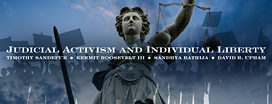Few political movements can boast a history of uninterrupted consistency, and this is no less true of Progressivism than of conservatism or any other –ism. While Prof. Upham’s discussion of the Progressive belief in History and the Volkgeist works for the original, authentic Progressives, I think it underestimates the degree to which Progressivism changed in the past half-century.
Woodrow Wilson could think unashamedly in terms of the Spirit of the People manifesting itself in collective action, but today’s Progressives do not think that way. They are, rightly, haunted by the experiences of World War II and the Civil Rights Era. Those episodes led Progressives to reintroduce certain elements of Good Old Fashioned Classical Liberalism into their creed—haltingly, and inconsistently, but still to everyone’s benefit. Today’s Progressives are rightly ashamed of much of their history—trying, for instance, to pretend that segregation was imposed by capitalist business tycoons instead of by Democratic Party reformers—and have, in an inconsistent and ultimately incoherent fashion, returned to some of the principles of liberty and equality that previous generations of Progressive leaders rejected.
That’s why it’s unconvincing for Prof. Upham to try to label the movement for marriage equality as the natural outcome of Progressivism. Look at a case like Goodridge v. Massachusetts Department of Health—an excellent, entirely convincing piece of reasoning which was ludicrously derided as an exercise in “judicial activism” when it was decided. Goodridge never speaks of any Hegelian process of Historical ramification. Instead, the court says—consistently with centuries of Anglo-American common law and the classical liberalism of the Declaration—that government restrictions on individual liberty must be justified by some realistic public purpose, as opposed to the arbitrary distaste of political elites. The court then goes through the various justifications advanced in support of prohibiting same-sex couples from marrying, and correctly finds them wanting. For instance, opponents of marriage equality argued that marriage was an institution designed to foster child-rearing. Yet child-rearing plays no necessary part in marriages, since infertile couples can marry or stay married, and same-sex couples are allowed to adopt. After examining in turn each justification offered for limiting the rights of same-sex couples, and finding each one unpersuasive, the court concluded that the restriction was arbitrary and therefore did not qualify as the due process of law to which all persons are entitled. This is Good Old Fashioned Classical Liberalism, not Progressivism.
One complicating factor in all of this is that Progressive doctrine is so malleable that it can easily be bent to serve a politically palatable outcome, and as a result, classical liberal theory is sometimes articulated in Progressive jargon. Lawrence v. Texas and Griswold v. Connecticut are good examples. These cases simply, and rightly, held that the state may not deprive people of liberty arbitrarily, and that the government’s mere distaste for a person’s actions—sex in the privacy of one’s home which politicians have decreed off limits—is arbitrary. In those cases, as in Goodridge, the state had prohibited private conduct that harmed nobody simply as an act of power—as an ipse dixit—though hidden under a pretext of protecting the public from some kind of harms. The Court saw through those pretexts and invalidated the laws—again, an exercise in ordinary classical liberalism. Sadly, because the Court is so Lochner-phobic that it saw fit to couch its reasoning in the jargon of Progressivism, or in silly terms like penumbras and emanations. But underneath that disguise, these decisions fit comfortably within the centuries-old Due Process of Law tradition.
It’s actually much harder to classify such decisions with the tradition of original Progressivism, not only given the fact that they run so strongly counter to majority will, but also because the original Progressives were actually quite Puritanical about sex. They even tried to make divorce illegal. As I’ve said, modern conservatives are much more Progressive than they often realize. The law struck down in Lawrence, for instance, was entirely in the Progressive vein. Whatever one thinks of the privacy rights revolution of the 1950s, the sexual revolution of the 1960s, and the decision in Lawrence v. Texas, they are not authentically Progressive. They are libertarian. To the degree Progressives have made room for any amount of libertarianism on their platform, they deserve praise.
Yes, the older variety of Progressivism is certainly alive and well. The notion that health care, for example is a “right”—provided by the state with funds forcibly seized from people’s earnings, and shoved down their throats in the form of government mandates—depends on the Progressives’ redefinition of “rights” as privileges given by the government. That’s certainly something Wilson, Brandeis, and their generation would have recognized. But as I noted earlier, Progressivism went through some healthy changes in the years following World War II. Liberals realized that there are such things as inalienable human rights that no state may justly abridge. The only regret is that they persist in blindness to the importance of other rights, such as private property and economic liberty.

